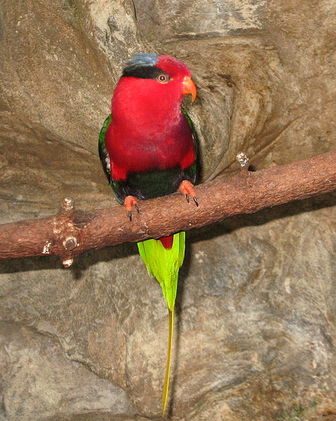Papuan Lorikeet

The Papuan Lorikeet is classified as Least Concern. Does not qualify for a more at risk category. Widespread and abundant taxa are included in this category.
Male: Papuan Lorikeets have both a red and melanistic (black) color phase. In the melanistic phase the red feathers are replaced by black ones. In the melanistic variety, the general plumage is red. The back and wings are dark green. There is a black patch on the back of the head streaked with blue at the front edge. There is a narrow black band across the back of neck. The lower back and upper tail-coverts have a blue patch. More
Papuan Lorikeets in tree, Baliem Valley © Mehd Halaouate | http://www.indonesien. More
Papuan Lorikeets have both a red and melanistic color phase. In the melanistic phase the red feathers are replaced by black ones. The top picture, taken in the San Diego Zoo, in March 2004, shows a Papuan Lorikeet in the melanistic variety on the left, and a regularly colored one on the right. The following picture, also taken in the San Diego Zoo in March 2004, shows the colors on the back of a regularly colored Papuan Lorikeet. More
Papuan Lorikeets live in the mountain forests of Central New Guinea. They fly silently, travelling singly or in pairs. Pairs fly close together, with their long tails streaming behind them. In full plumage the Papuan Lorikeet is unmistakable, as the only lorikeet with a long trailing tail. It has a loud distinctive call, unlike any other lorikeet. The female lays two eggs in a hole in a tree. Both parents help to incubate the eggs and rear the chicks. More
Wild Papuan Lorikeet feeding on flowering tree Credit: © Ron Hoff photos Photos videoVideo 1 eNewsletter SIGNUP FOR EMAIL UPDATES Did You Know?Three out of the four races of this species have melanistic (dark) phases. The nominate has no dark colouration. More

Original source: Philip Shoffner
Author: Philip Shoffner
Permission: Some rights reserved
Family : Psittacidae
Genus : Charmosyna
Species : papou
Authority : (Scopoli, 1786)
